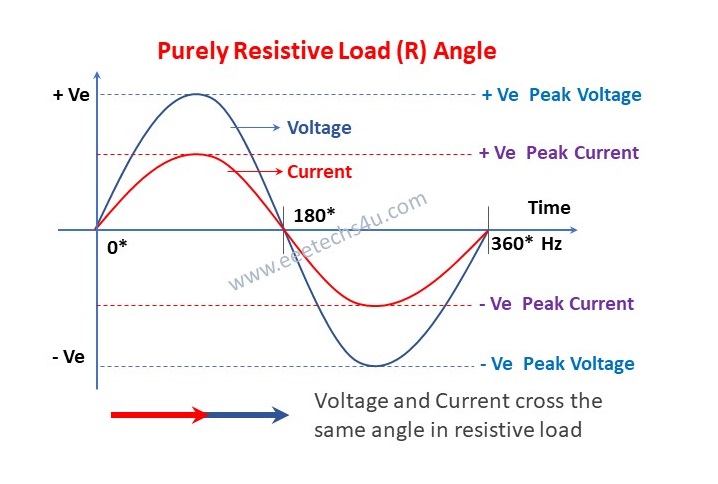This article describes in detail what a resistive load on electricity is and its advantages and disadvantages. It discusses resistive load, examples, characteristics and power consumption of resistive loads. There are three main types of loads depending on the nature of the electric load. The first load is the Resistive load, the second the Inductive load, and the third the Capacitive load. All of these have different natures, advantages and disadvantages. Let us look at the first of these, the resistive load.
A resistive load reactance is zero, so that the alternating current is at the same phase as the voltage. These loads also known as non-reactive loads.
Voltage and current travel in parallel at the same angle at the pure resistive load (180, 360 angles). Resistive loads are known as 'R' loads.
What is Resistive Load?
All heating loads are called as resistive load.
Simply put, a load is any electrical device that consumes and converts electrical energy. Resistive load is an electrical load that uses 100% of its electricity in its pure form and shows its protective effect. Its protective effect depends on two factors. The first is that such loads try to block the flow of electric current. The second is the ability to convert it into thermal energy by blocking the flow of electricity. Therefore, any electrical load that converts electrical energy into thermal energy is called a resistive load. Although multiple definitions can be used to describe a resistive load, it can be understood in the following way.
Examples of Resistive Load
Nowadays, we see around many examples of resistive load used in industrial applications and domestic use. So here are some examples:
1, Incandescent lamps, which convert electrical energy into light and heat.
2, An electric water heater is a resistive load used in most common homes.
3, Electric iron
4, Room heater
5, Electric soldering iron
6, Load bank used for electrical load testing
Resistive Load Properties and Characteristics
- The voltage and current used by a resistive load will always be the same wavelength.
- Resistive load has the same effect on AC and DC, but requires more AC current than DC to perform the same function.
- Since voltage and current are the same wavelength, the wave difference or angle between voltage and current is always zero. So resistive loads always act on the unity power factor.
- Resistive load never stores electricity, in fact, it dissipates electrical energy in the form of heat and light.
- Since the resistive load always uses the unit power factor, only the active power is used. However, its apparent power and active power are always equal.
- Electrical energy for a resistive load always flows from the source to the load. No reverse feedback current like capacitive load or inductive load.
- Resistive loads are constant current consumption loads. So, it will not have the differences of an inductive load like an electric induction motor.
- In electricity resistive loads are maintain unity power factor.

